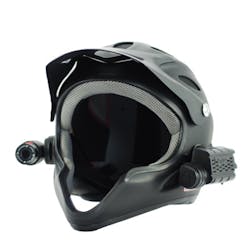Remote monitoring: Wireless helmet camera checks pit-crews work
Anyone who has ever watched an automobile racing event organized by The National Association for Stock Car Auto Racing (NASCAR; Daytona Beach, FL, USA;www.nascar.com) will be amazed at the speed of the technicians who are tasked with refueling and changing the tires in the pit. So fast are these tasks required to be accomplished that often technicians never have the chance to check their own work to ensure that newly fitted tires have the correct number of lug nuts attached to them.
"While the coach for a racing team may see one side of the car from the pit, there is no time for him or her to perform a complete inspection of the far side of the car," says Tom Brennan, President of Artemis Vision (Denver, CO, USA;www.artemisvision.com).
To overcome this, Brennan and his colleagues have developed a wireless helmet camera that sends images back to the pit in real-time from each helmet of a pit crew (Figure 3). In this way, each of the tires on the stock car can be remotely examined and, if necessary, technicians can be alerted of any possible discrepancy.
In developing the system, a Replay PrimeX 16MPixel camera from Replay XD (Newbury Park, CA, USA;www.replayxd.com) fitted with a T2.8 145° CinePrime X Lens wide angle lens from Hyperion Development (San Ramon, CA, USA; www.hyperion-development.com) is mounted to one side of the helmet. To transmit image data from the camera, HDMI data from the camera is encoded by a wireless transmitter mounted at the opposite side of the helmet.
"Using this wireless transmitter, image data can be broadcast at up to 300ft from the helmet to a receiver located in the pit," says Brennan. As data is received by the receiver, it is displayed on an HDMI monitor . Simultaneously, HDMI output from the receiver is also recorded on an SD card using an UltraStudio for USB 3.0 unit developed by Blackmagic Design (Fremont, CA, USA;www.blackmagicdesign.com). As well as storing incoming HDMI video streams at 720p resolution at 60ps or 1080p at 30fps, the unit's USB 3 output allows images to be transferred to a host computer.
"In this way," says Brennan, "it is possible to perform image analysis on the image data." Indeed, Brennan and his colleagues have already prototyped image processing algorithms that will allow the host CPU to locate lug nuts located on tires found within image sequences. "Should lug nuts be missing, it is feasible that the system could automatically alert the viewer of such occurrences and alert the pit crew," says Brennan.
At present, the prototype system has been successfully tested at a number of NASCAR races by Germain Racing (Mooresville, NC, USA;www.germainracing.com), a NASCAR Sprint Cup Series racing team.
"The pit crew helmet will give the crew chief immediate feedback regarding any damage to the right side of the vehicle that cannot be seen from the pit box. It may also help diagnose loose wheels after pit stops by showing on what wheel a tire changer may have missed under-tightened nuts," says Chris Andrews, Technical Director at Germain Racing,
Today, the cost of a two helmet system is, in its present configuration, approximately $20,000 although this cost is expected to be lower for volume production. Such systems will not be limited to the world of auto-sports, however. "Wireless cameras could be configured for emergency medical technicians (EMTs) to transmit images of a patient en-route to a hospital, for example, providing medical personnel at the hospital prior knowledge of a patient's status before they are admitted. Alternatively, they could be used in remote support procedures to help technicians diagnose complex equipment," Brennan says.


